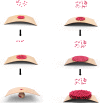A New Mechanistic Model for Viral Cross Protection and Superinfection Exclusion
- PMID: 29422912
- PMCID: PMC5788904
- DOI: 10.3389/fpls.2018.00040
A New Mechanistic Model for Viral Cross Protection and Superinfection Exclusion
Abstract
Plants pre-infected with a mild variant of a virus frequently become protected against more severe variants of the same virus through the cross protection phenomenon first discovered in 1929. Despite its widespread use in managing important plant virus diseases, the mechanism of cross protection remains poorly understood. Recent investigations in our labs, by analyzing the whole-plant dynamics of a turnip crinkle virus (TCV) population, coupled with cell biological interrogation of individual TCV variants, revealed possible novel mechanisms for cross protection and the closely related process of superinfection exclusion (SIE). Our new mechanistic model postulates that, for RNA viruses like TCV, SIE manifests a viral function that denies progeny viruses the chance of re-replicating their genomes in the cells of their "parents," and it collaterally targets highly homologous superinfecting viruses that are indistinguishable from progeny viruses. We further propose that SIE may be evolutionarily selected to maintain an optimal error frequency in progeny genomes. Although primarily based on observations made with TCV, this new model could be broadly applicable to other viruses as it provides a molecular basis for maintaining virus genome fidelity in the face of the error-prone nature of virus replication process.
Keywords: cross protection; p28; protein polymerization; superinfection exclusion; turnip crinkle virus.
Figures



Similar articles
-
A self-perpetuating repressive state of a viral replication protein blocks superinfection by the same virus.PLoS Pathog. 2017 Mar 7;13(3):e1006253. doi: 10.1371/journal.ppat.1006253. eCollection 2017 Mar. PLoS Pathog. 2017. PMID: 28267773 Free PMC article.
-
The Matrix Protein of a Plant Rhabdovirus Mediates Superinfection Exclusion by Inhibiting Viral Transcription.J Virol. 2019 Sep 30;93(20):e00680-19. doi: 10.1128/JVI.00680-19. Print 2019 Oct 15. J Virol. 2019. PMID: 31341043 Free PMC article.
-
Superinfection Exclusion by p28 of Turnip Crinkle Virus Is Separable from Its Replication Function.Mol Plant Microbe Interact. 2020 Feb;33(2):364-375. doi: 10.1094/MPMI-09-19-0258-R. Epub 2019 Dec 27. Mol Plant Microbe Interact. 2020. PMID: 31880982
-
Natural Selection, Intracellular Bottlenecks of Virus Populations, and Viral Superinfection Exclusion.Annu Rev Virol. 2022 Sep 29;9(1):121-137. doi: 10.1146/annurev-virology-100520-114758. Epub 2022 May 13. Annu Rev Virol. 2022. PMID: 35567296 Review.
-
Bottleneck, Isolate, Amplify, Select (BIAS) as a mechanistic framework for intracellular population dynamics of positive-sense RNA viruses.Virus Evol. 2020 Nov 12;6(2):veaa086. doi: 10.1093/ve/veaa086. eCollection 2020 Jul. Virus Evol. 2020. PMID: 33343926 Free PMC article. Review.
Cited by
-
Persistent Southern Tomato Virus (STV) Interacts with Cucumber Mosaic and/or Pepino Mosaic Virus in Mixed- Infections Modifying Plant Symptoms, Viral Titer and Small RNA Accumulation.Microorganisms. 2021 Mar 26;9(4):689. doi: 10.3390/microorganisms9040689. Microorganisms. 2021. PMID: 33810543 Free PMC article.
-
Detection of Plant Viruses and Disease Management: Relevance of Genetic Diversity and Evolution.Front Plant Sci. 2020 Jul 17;11:1092. doi: 10.3389/fpls.2020.01092. eCollection 2020. Front Plant Sci. 2020. PMID: 32765569 Free PMC article. Review.
-
SARS-CoV-2 cellular coinfection is limited by superinfection exclusion.J Virol. 2025 Apr 15;99(4):e0207724. doi: 10.1128/jvi.02077-24. Epub 2025 Mar 21. J Virol. 2025. PMID: 40116503 Free PMC article.
-
Scanning the Horizon for Environmental Applications of Genetically Modified Viruses Reveals Challenges for Their Environmental Risk Assessment.Int J Mol Sci. 2024 Jan 25;25(3):1507. doi: 10.3390/ijms25031507. Int J Mol Sci. 2024. PMID: 38338787 Free PMC article. Review.
-
Venezuelan equine encephalitis virus non-structural protein 3 dictates superinfection exclusion in mammalian cells.Npj Viruses. 2024 Sep 13;2(1):43. doi: 10.1038/s44298-024-00055-z. Npj Viruses. 2024. PMID: 40295792 Free PMC article.
References
-
- Blake J. A., Lee K. W., Morris T. J., Elthon T. E. (2007). Effects of turnip crinkle virus infection on the structure and function of mitochondria and expression of stress proteins in turnips. Physiol. Plant. 129 698–706. 10.1111/j.1399-3054.2006.00852.x - DOI
-
- Chewachong G. M., Miller S. A., Blakeslee J. J., Francis D. M., Morris T. J., Qu F. (2015). Generation of an attenuated, cross-protective Pepino mosaic virus variant through alignment-guided mutagenesis of the viral capsid protein. Phytopathology 105 126–134. 10.1094/PHYTO-01-14-0018-R - DOI - PubMed
Publication types
LinkOut - more resources
Full Text Sources
Other Literature Sources

